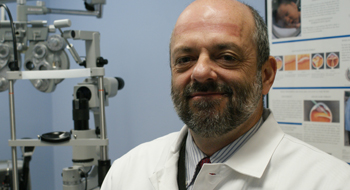Eyal Margalit, M.D., Ph.D., has been named the 2010 Joseph P. Gilmore Award recipient for his work to develop an electronic retinal implant to restore vision in blind patients.
 |
Eyal Margalit, M.D., Ph.D. |
Though diseases like retinitis pigmentosa and age related macular degeneration damage the eyes’ photoreceptors — the cells responsible for vision — other cells in the retina stay intact, Dr. Margalit said.
“In the late ’80s and early ’90s, the idea came about to use electricity for retinal cells’ stimulation,” Dr. Margalit said. “Ideally, the electrical stimulation would cause the brain to see light and create an image.”
|
He came to UNMC in 2003, while researchers from Johns Hopkins (now at the University of Southern California) continued work on the retinal implant. They now seek U.S. Food and Drug Administration approval on a device with approximately 60 electrodes.
It is estimated, however, that it takes a minimum of 600 electrodes to stimulate the retina cells before humans begin to see enough detail for face recognition.
In collaboration with the Naval Research Laboratory and with funds from the U.S. Department of Veterans Affairs and the Nebraska Research Initiative, Dr. Margalit plans to improve an existing device with one that contains 3,200 electrodes.
It will be three to five years before Dr. Margalit’s device is tested in clinical trials.